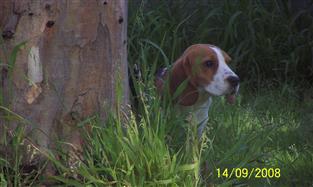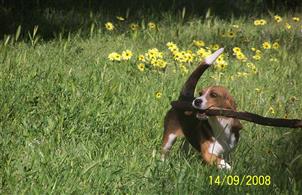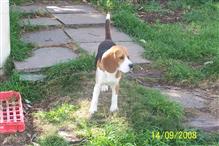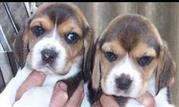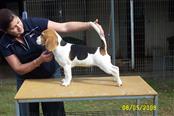
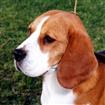

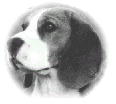
Information
INTRODUCING THE BEAGLE
It is pleasing to know you are interested in the Beagle. Here is some information about the breed prepared by Marion Watson and the West Australian Beagle Club.
The Beagle is one of the oldest of pure bred hounds, his ancestors being traced back to Greece in about 400 BC. In Britain it has been mentioned in early literature such as Chaucer's 14th Century Canterbury Tales and it was a favourite of several monarchs such as Henry VI & VIII, Charles II and Elizabeth I. Also in Britain it has been used as a hunting hound since the 14th century and packs of them are still used to hunt hare. However, the Beagle has been domesticated very successfully during recent years and is now a very popular pet and show dog.
In appearance the Beagle is a lively, sturdy looking hound having several colours. The most common is the tricolour, a combination of black, white and tan, but there are other combinations such as black and tan, tan and white, and lemon and white which are extremely attractive and are becoming more popular. The stern (tail) should always have a white tip and the eyes should be dark. Its coat is short, dense and waterproof, making it easy to groom and keep clean. It is of medium size, being between 13" and 16" high, measured from the top of the shoulder vertically to the ground, thus it can fit easily into most households and cars. The pocket Beagle, which should be under 10" high, is virtually extinct.
The Beagle is a merry hound, full of stamina. He should be bold, alert and have an even temperament. Even though he has been domesticated he still retains the instinct to hunt by scent. A Beagle likes the company of people and other dogs and is good with children. He should therefore not be kept in a household where he is going to be left alone all day.
For a normal healthy Beagle this should be no problem as he will eat well on most easily obtainable dog foods, whether they be fresh, tinned or dehydrated. Indeed, it can be a problem preventing him from eating too much, so a regular meal schedule should be established with no extras in between. A reputable breeder will provide a diet sheet.
All dogs require exercise, the Beagle no more or less than any other hound, gundog or terrier. But he is not a lap dog and will require more than an occasional wander around the block on a lead. A regular 30 minutes a day free running is the ideal minimum.
If all breeds were as healthy as the Beagle many vets would go out of business. Providing they are looked after, they will rarely need veterinary attention. They will of course, require their vaccinations against disease and regular anti-worm treatment.
A naturally clean animal, the Beagle is easy to groom, requiring only a few minutes brushing daily and an occasional bath.
From the foregoing, it can be seen that the ideal home for a Beagle is not a small flat in a busy built up area. He is best at home in the country or suburbs where he can be freely exercised. Although he will make himself at home in the house, an outside run in the garden is the ideal. His owners should be prepared to devote time to him, especially as a puppy being trained. In return, the Beagle will prove to be a fine companion on walks, exercising himself and his owner. Ownership of a Beagle can lead to a more interesting social life
Without doubt go to a reputable breeder. If you do not know of one, either the Beagle Club of W.A. or the Canine Association of W.A.) or a vet can put you in touch with one in your own area. A Beagle Club recommended breeder will always be concerned where his puppies go. He will provide a diet sheet and pedigree form and will always be willing to help a new Beagle owner with problems which may occur. In other words, he will offer an "after sales" service which puppy farms and pet shops will not do. This is why it is strongly recommended that any prospective buyer go to a recommended breeder rather than a pet shop or puppy farm, where possibly a high price will be paid for poor quality and possibly unhealthy stock.
A reputable breeder will spend some time finding out if the prospective buyer and his home are suitable for a Beagle, so please do not object to a lot of questions which are to satisfy the breeder that his puppies are not being purchased for re-sale to research or vivisection.
It is always difficult to predict as prices of kenneling, feeding and veterinary fees etc are constantly spiraling. A potential show dog could cost considerably more than a pet or family companion. Prospective puppy buyers should ensure that the price includes the first needle and that the puppy has been started on a worming program and is possibly Micro chipped..
Some W.A. Beagle Club activities are grooming and show training classes, fun events, members competitions and social activities.
It is hoped that this information has provided you with sufficient information about the Beagle enabling you to decide whether or not you wish to be owned by one!
|
